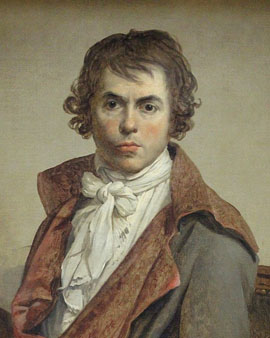The French painter Jacques-Louis David became famous above all through a series of classicist history paintings. As a Jacobin member of the National Convention and the Security Committee, he was a prominent player on the political stage during the French Revolution. Among his painted commentaries of this period of upheaval were above all "Die Ermordung des Marat" (1793). David later became a transfiguree of the imperial era with works such as "Krönung Napoleons I." (1806).
Art historians associate David with the breakthrough of classicism in painting. In 1785 David's oil painting "Der Schwur der Horatier" (1784) was presented to the public with enormous success. The painting, which in clear contrast to the playfulness of the rococo painting that had dominated until then, propagated determination and a will to act, represents a pathetic scene from early Roman history: The three brothers of the Horatier family are to fight for Rome against Alba Longa in a proxy fight to the death. Before the fight, the father takes the oath of arms from his sons and holds their swords. In contrast to this group of four determined by energy and fighting tension, David has placed women crouching in mourning. A dark background and antique arcade elements complete the picture composition. In retrospect, David's contemporaries speculated on the call for revolution into the picture, which today appears rather stiff.
The painter, who was ostracized as a revolutionary, was driven out of France after 1815 by the Restoration. He died in 1825 at the age of 77 in exile in Brussels.
×





.jpg)
.jpg)
.jpg)
.jpg)
.jpg)
.jpg)
.jpg)
.jpg)
.jpg)
.jpg)
.jpg)
.jpg)


.jpg)
.jpg)
.jpg)
.jpg)
 - (MeisterDrucke-96538).jpg)
 - (MeisterDrucke-96538).jpg)
.jpg)
.jpg)
.jpg)
.jpg)
.jpg)
.jpg)
.jpg)
.jpg)
.jpg)
.jpg)
 Crossing the Alps at the St Bernard Pass 20th May 1800 c1800-01 - (MeisterDrucke-78037).jpg)
 Crossing the Alps at the St Bernard Pass 20th May 1800 c1800-01 - (MeisterDrucke-78037).jpg)
.jpg)
.jpg)
.jpg)
.jpg)
.jpg)
.jpg)
.jpg)
.jpg)
.jpg)
.jpg)
.jpg)
.jpg)
.jpg)
.jpg)
.jpg)
.jpg)
.jpg)
.jpg)
_1790_-_(MeisterDrucke-577142).jpg)
_1790_-_(MeisterDrucke-577142).jpg)
.jpg)
.jpg)
.jpg)
.jpg)
.jpg)
.jpg)
.jpg)
.jpg)
.jpg)
.jpg)
.jpg)
.jpg)
_handsome_brother_of_the_artist_Painting_-_(MeisterDrucke-948115).jpg)
_handsome_brother_of_the_artist_Painting_-_(MeisterDrucke-948115).jpg)
_murdered)_Painting_by_Jacques_Lo_-_(MeisterDrucke-1022141).jpg)
_murdered)_Painting_by_Jacques_Lo_-_(MeisterDrucke-1022141).jpg)
.jpg)
.jpg)
.jpg)
.jpg)
_murdered_in_his_bathtub_on_130717_-_(MeisterDrucke-1001875).jpg)
_murdered_in_his_bathtub_on_130717_-_(MeisterDrucke-1001875).jpg)
_murdered)_Detail_Painting_by_Jac_-_(MeisterDrucke-1002786).jpg)
_murdered)_Detail_Painting_by_Jac_-_(MeisterDrucke-1002786).jpg)
.jpg)
.jpg)
.jpg)
.jpg)
.jpg)
.jpg)
 - (MeisterDrucke-69632).jpg)
 - (MeisterDrucke-69632).jpg)
.jpg)
.jpg)
 and the - (MeisterDrucke-374877).jpg)
 and the - (MeisterDrucke-374877).jpg)
_dans_son_cabinet_de_travail_aux_Tui_-_(MeisterDrucke-1171245).jpg)
_dans_son_cabinet_de_travail_aux_Tui_-_(MeisterDrucke-1171245).jpg)
.jpg)
.jpg)
.jpg)
.jpg)
.jpg)
.jpg)
.jpg)
.jpg)
.jpg)
.jpg)
_1798-99_-_(MeisterDrucke-34698).jpg)
_1798-99_-_(MeisterDrucke-34698).jpg)
.jpg)
.jpg)
.jpg)
.jpg)
.jpg)
.jpg)
.jpg)
.jpg)
 - (MeisterDrucke-74224).jpg)
 - (MeisterDrucke-74224).jpg)
.jpg)
.jpg)
.jpg)
.jpg)
.jpg)
.jpg)
.jpg)
.jpg)
_had_to_drink_cig_-_(MeisterDrucke-924723).jpg)
_had_to_drink_cig_-_(MeisterDrucke-924723).jpg)
.jpg)
.jpg)
_-_(MeisterDrucke-1660940).jpg)
_-_(MeisterDrucke-1660940).jpg)
.jpg)
.jpg)
_Two_Drapery_Studies_for_t_-_(MeisterDrucke-1280141).jpg)
_Two_Drapery_Studies_for_t_-_(MeisterDrucke-1280141).jpg)
.jpg)
.jpg)
_Jeanne_Francoise_dite_Juliette_-_Paint_-_(MeisterDrucke-948178).jpg)
_Jeanne_Francoise_dite_Juliette_-_Paint_-_(MeisterDrucke-948178).jpg)
.jpg)
.jpg)
.jpg)
.jpg)
.jpg)
.jpg)
.jpg)
.jpg)
.jpg)
.jpg)
.jpg)
.jpg)
.jpg)
.jpg)
.jpg)
.jpg)
.jpg)
.jpg)
.jpg)
.jpg)
 - (MeisterDrucke-103750).jpg)
 - (MeisterDrucke-103750).jpg)
.jpg)
.jpg)
 (see also 14667) - (MeisterDrucke-42446).jpg)
 (see also 14667) - (MeisterDrucke-42446).jpg)
.jpg)
.jpg)
_Painting_by_Jacques_Louis_David_(1748_-_(MeisterDrucke-970094).jpg)
_Painting_by_Jacques_Louis_David_(1748_-_(MeisterDrucke-970094).jpg)
.jpg)
.jpg)
 - (MeisterDrucke-168138).jpg)
 - (MeisterDrucke-168138).jpg)
.jpg)
.jpg)
_Sun_1_-_(MeisterDrucke-951199).jpg)
_Sun_1_-_(MeisterDrucke-951199).jpg)
.jpg)
.jpg)
_-_(MeisterDrucke-1660106).jpg)
_-_(MeisterDrucke-1660106).jpg)
 c1797-98 - (MeisterDrucke-79905).jpg)
 c1797-98 - (MeisterDrucke-79905).jpg)
.jpg)
.jpg)
_-_(MeisterDrucke-361265).jpg)
_-_(MeisterDrucke-361265).jpg)
 - (MeisterDrucke-89182).jpg)
 - (MeisterDrucke-89182).jpg)
 1790s - (MeisterDrucke-93054).jpg)
 1790s - (MeisterDrucke-93054).jpg)
.jpg)
.jpg)
_-_(MeisterDrucke-92721).jpg)
_-_(MeisterDrucke-92721).jpg)
.jpg)
.jpg)
.jpg)
.jpg)
.jpg)
.jpg)
.jpg)
.jpg)
.jpg)
.jpg)






